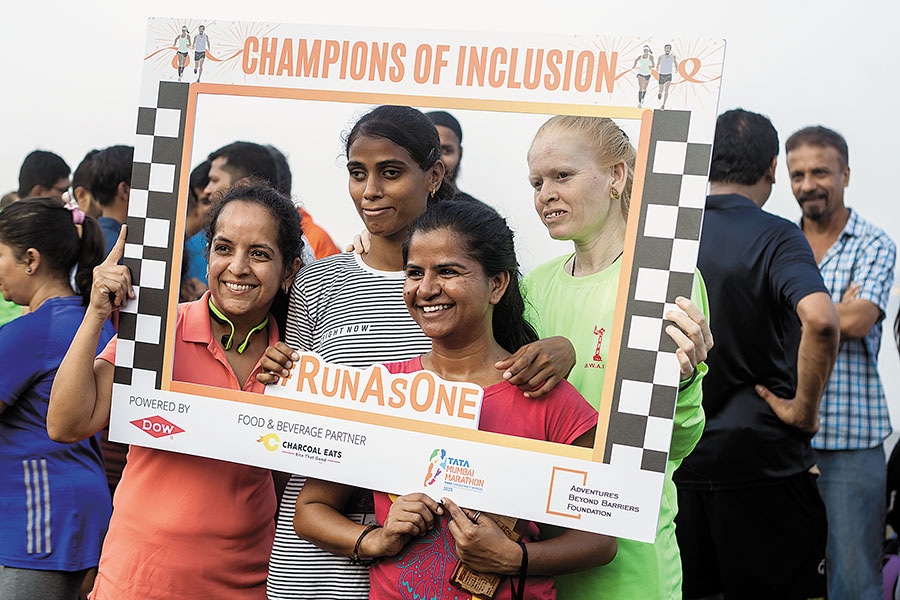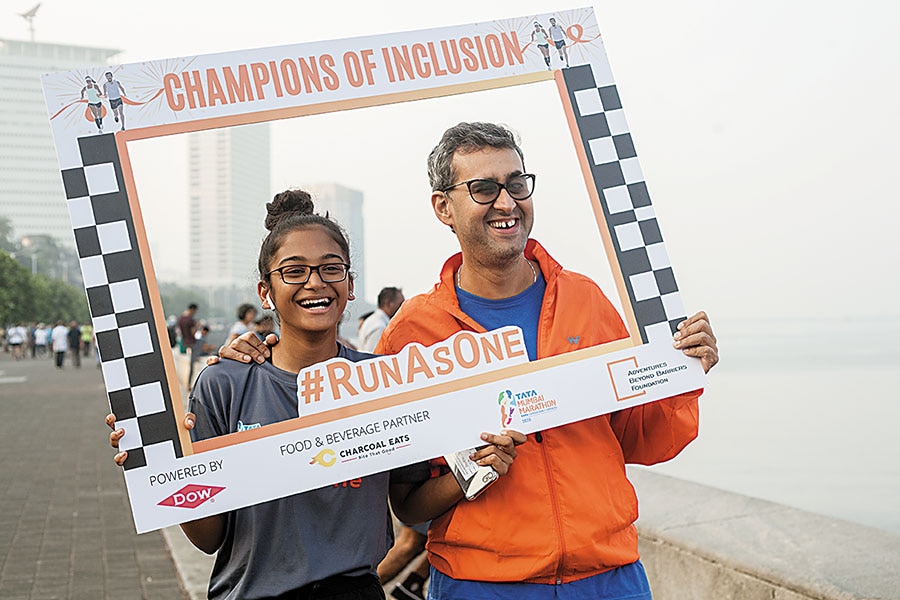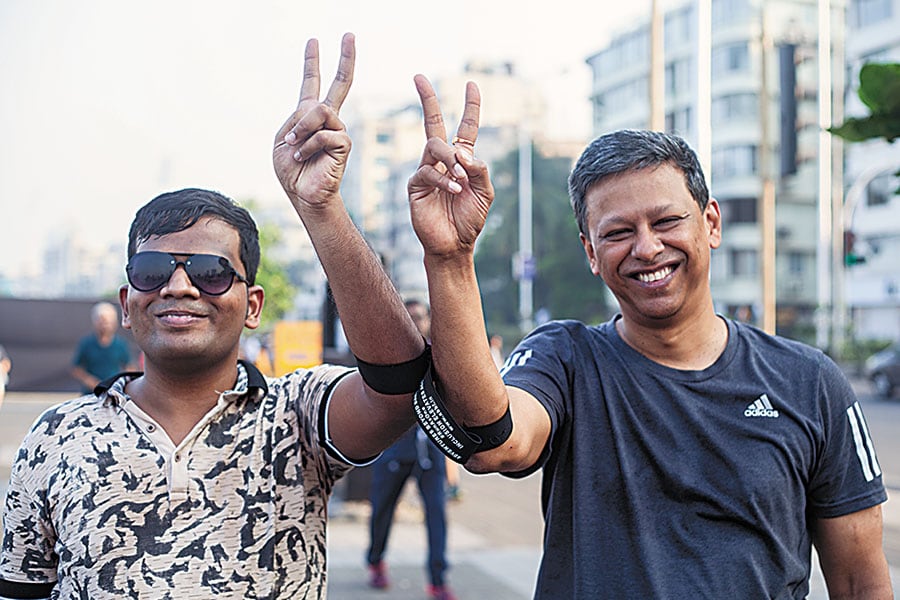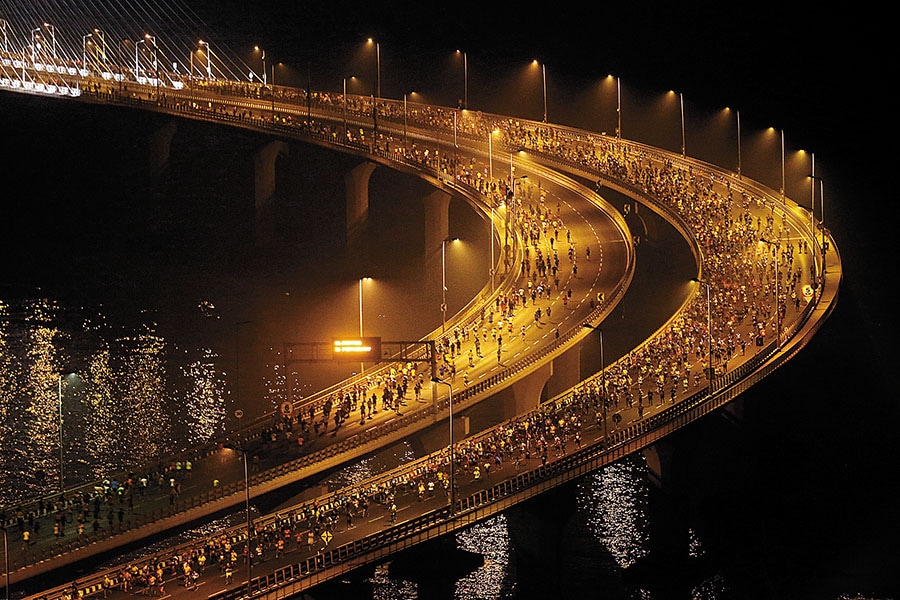The Mumbai marathon gets more inclusive, with helping hands
At the next Mumbai marathon, disabled participants will run in the 10-km category


 The Adventure Beyond Barriers Foundation has been promoting inclusivity through sport since 2014
The Adventure Beyond Barriers Foundation has been promoting inclusivity through sport since 2014
Images: Aditi Tailang[br] The last few weekends have been liberating for Preetham Sunkavalli. Ever since Class 6, the visually impaired 24-year-old has been doing his runs on a treadmill at home or at the office gym. Though he routinely pulls off 5 km, it is nothing quite like running outdoors.
All that changed one Sunday in November, when the Adventure Beyond Barriers Foundation (ABBF) handed Sunkavalli the opportunity to hit the road alongside Bimal Goculdas, managing director at Dharamsi Morarji Chemical, and together they completed a 7-km run along Mumbai’s Marine Drive. Things will only get better, when the two run together at the 17th edition of the Tata Mumbai Marathon (TMM) next January.
Along with Sunkavalli, there will be 124 other disabled participants at the marathon who will, for the first time, run in the open 10-km category alongside their able-bodied and sighted partners, who lead some of the top corporations in India. In the past, most disabled runners had been restricted to the 1.5-km ‘Champions with Disability’ category. While there were 290 disabled runners at the 2015 edition of the marathon, the number went up to 1,301 in 2019, among a total of around 46,000 participants. ABBF founder Divyanshu Ganatra (in orange jacket and glasses), a self-made social entrepreneur, also happens to be India’s first blind solo pilot[br]In preparation for the event, ABBF has been organising training sessions at Mumbai’s Marine Drive, a 3.6-km stretch along the Arabian Sea, where disabled (mostly visually impaired) runners are being paired with sighted runners who will guide them in the January event.
ABBF founder Divyanshu Ganatra (in orange jacket and glasses), a self-made social entrepreneur, also happens to be India’s first blind solo pilot[br]In preparation for the event, ABBF has been organising training sessions at Mumbai’s Marine Drive, a 3.6-km stretch along the Arabian Sea, where disabled (mostly visually impaired) runners are being paired with sighted runners who will guide them in the January event.
While the development may seem like a one-off day worth celebrating, Divyanshu Ganatra considers it to be a major milestone. Ganatra is the founder of ABBF and has used sport as a medium to drive the cause of inclusivity since 2014. He approached Procam International, organisers of TMM, and became their official ‘Inclusion Ally’. While they are starting out with the 10-km run this year, the idea is to eventually open all race categories to persons with disabilities.
“It’s a great way to showcase to the corporate world what inclusion looks like as an experience. TMM is a huge platform and there’s nothing quite like spreading the word on inclusivity from the shoulders of giants,” Ganatra says. Running for the cause was an easy sell to corporates, and those who came on board needed little convincing.
According to the World Health Organization, around 15 percent of a developing country’s population has some form of disability, which pegs the number at around 200 million in India. “Not many know about this, since we probably don’t see a lot of people from the community on a daily basis,” says Anurag Mehrotra, CEO of Charcoal Eats, who has agreed to ABBF’s request to be part of the next TMM. “The prospect of bringing about awareness excited me and it’s a good way to get the ball rolling for the cause of inclusion at our organisation.”
For Ashok Nair, MD of Abbott India, being part of the TMM and highlighting the cause of inclusivity is an extension of his role as a leader: “Just 1 percent of the disabled are employed by companies in India and the numbers have barely risen in the last 10 years. It means we are not utilising the true potential of so many individuals. An inclusive run which brings people with different abilities together is a step in the right direction.”
*****
Ganatra lost his eyesight at 19. Though the next few months were a struggle, he soon accepted reality and chose to teach himself how to set up communication servers and work with web technology in the late 1990s. “I would get all kinds of encouraging reactions when they heard of a blind guy running an IT company. But the truth is, a majority of my contracts would not work out the moment they heard I was blind,” he recalls.
He went on to study psychology and cognitive neuroscience at Fergusson College, Pune, followed by a stint in the human resources department of the Tata Group in 2005. He established ABBF in 2014 to mobilise the community through outdoor activities such as running, trekking, paragliding, cycling and scuba diving. Visually impaired runners and their sighted partners use a band to communicate[br]At one of his first ABBF runs in 2016 in Pune, visually impaired Tony Kurian was teamed up with the owner of a local construction company to lead him on the 5-km course. “My parents were really worried when I stepped out for that first run. But I knew I would be alright since I had a partner,” says Kurian, who will be running the TMM. “Ever since, running has brought about a lot of positivity in my life.”
Visually impaired runners and their sighted partners use a band to communicate[br]At one of his first ABBF runs in 2016 in Pune, visually impaired Tony Kurian was teamed up with the owner of a local construction company to lead him on the 5-km course. “My parents were really worried when I stepped out for that first run. But I knew I would be alright since I had a partner,” says Kurian, who will be running the TMM. “Ever since, running has brought about a lot of positivity in my life.”
Running with a partner is something that takes getting used to, for both runners. For instance, on her first training run at Marine Drive in November with a 20-year-old visually impaired runner, the only anxiety that Anuradha Nath, executive director at Morgan Stanley, had was about keeping up with her partner, who was much faster than her.
For Goculdas, his second practice run with Sunkavalli put a lot of things in perspective. “The main focus was to avoid bumping into people, since there are a lot of runners on Marine Drive on Sunday. There cannot be verbal instructions all the time, since it affects breathing. We were tethered by a band, which takes a few minutes of getting used to. After that, a tug on the arm is the best way to guide your partner,” he says. The next edition of the Tata Mumbai Marathon will have a 10-km run for persons with disabilities
The next edition of the Tata Mumbai Marathon will have a 10-km run for persons with disabilities
Image: Francis Mascarehas/Reuters[br]At the 2019 TMM, Sudhir Shenoy, CEO at Dow India, ran alongside Ekinath Khedekar, who suffers from retinitis pigmentosa. When Khedekar had taken to running in 2007, he would hold his white cane horizontally ahead of him, thus severely restricting his movements. Then in 2013, he suffered a knee injury that dented his sporting ambitions. It was Shenoy who got him back on track by not only teaming up with him, but also roping in two more runners to clear the route in front of them.
“On my first run, I couldn’t understand why my partner was running so awkwardly. It’s incredible to realise that a lot of them have never run in their life. A guide puts a lot of confidence in them and within a short period, you realise that you are the disabled one in the partnership,” Shenoy says. “It’s our job to ensure they don’t run into obstacles, so we came up with our own technique. For instance, when there’s a speed breaker, I say ‘3-2-1’ and that’s when he takes a jump. Once this is sorted, it’s a beautiful experience you tell him about the world you see, while he uses all his other senses and tells you about what he’s observing.”
***** A few events such as the Boston Marathon allow runners with eligible impairments to participate in the general category
A few events such as the Boston Marathon allow runners with eligible impairments to participate in the general category
Image: David L. Ryan/The Boston Globe Via Getty Images[br]A few events around the world such as the Chicago Marathon and the Boston Marathon have allowed runners with eligible impairments to participate in the general categories. Boston was the first major race to introduce a wheelchair division in 1975. At the 2020 edition, the organisers plan on awarding separate prizes for the wheelchair category, besides another two for visually impaired runners and amputees. Ganatra, however, highlights how a few races like the London Marathon have a run for disabled athletes a day before the main race, which contradicts the idea of inclusivity.
Jason Romero, from Colorado, US, is the only legally blind runner to have run across the breadth of the US. He has found running to be therapeutic, and it has helped him manage depression. It has also given him a career as a motivational speaker and an author, having written Running into the Dark.
“I usually wear a ‘Blind’ tag on my race belt and people have been very encouraging. The entire field at TMM should be notified that there will be challenged athletes on the course. As for these runners, I believe they are pioneers and carry a lot of responsibility, since they are running not just for themselves [but for the community],” says Romero. India’s first blade runner Major DP Singh (seen here with super-model Milind Soman) has run marathons in the open category
India’s first blade runner Major DP Singh (seen here with super-model Milind Soman) has run marathons in the open category
Image: Abhinav Saha/Hindustan Times Via Getty Images[br]In India, a few exceptions have been made in the past for disabled runners with experience, by allowing them to run in open categories. Visually impaired runner Amarjeet Singh Chawla has finished over a hundred half marathons, including the Tata Mumbai Marathon, although he has often struggled to get a sighted ally. In 2016, war veteran and blade runner DP Singh was announced as event ambassador for the Kargil International Marathon, organised by Pune-based Run Buddies, where he also ran the course. Other running events organised by Run Buddies see regular participation from Pune’s Queen Mary’s Technical Institute for Differently Abled Soldiers.
“Including disabled runners as part of the main category at TMM is a brilliant initiative. It will get others to realise that there is no need to keep them apart from the crowd, even outside of running,” says Arvind Bijwe, co-founder of Run Buddies.
*****
Most of the disabled participants at the TMM have visual and hearing impairments, while a few are intellectually disabled. Besides their inclusion in the 10-km category, TMM has also relaxed timings for disabled runners to be eligible for the half marathon. “To open up a category, and relax the timings will certainly boost the morale of the differently abled participants. This could be the beginning of a new trend in the Indian running ecosystem,” says Vivek Singh, joint managing director, Procam International.
According to Ganatra, the cause for diversity and inclusion has only been looked at seriously over the last three years. “It’s all very new and completely disorganised, so a lot of companies don’t know where to go and procure talent from. There are still attitudinal barriers and apprehensions towards policy and infrastructural changes. So most choose to focus on gender diversity for now as compared to other forms of inclusion,” he says. “We need to build cultures of openness that are more celebratory of our differences. We’ve been taught to be tolerant, but what we need is to be more accepting.”
Dhanpal Jhaveri, managing partner at Everstone Capital, has observed the potential of people with disabilities across the organisation’s businesses, and readily agreed to run for the cause at TMM. At home he has witnessed the development of a congenitally blind grandnephew, who excelled when he was handed the opportunity to learn and experiment. “The moment you have an appreciation of things, people start making changes—everything, from infrastructure to accessibility—which I still think is a major issue,” he says.
Most agree there is a need for a general change in attitude and policies. Gunjan Shakya, a banker from Nagpur who lost her eyesight at 13, believes there is hesitation in society, simply because of a lack of awareness about the capabilities of the disabled. The reservation for disabled workers in the government sector helped her secure a job with Bank of Baroda, but it was a struggle when it came to a private set-up.
For now, though, her concerns are different, as a first-timer at the upcoming TMM. “I’ve heard Mumbai is notorious for its potholes, so I hope my running partner can point them out to me in advance to avoid any mishaps,” she says with a laugh.
First Published: Dec 14, 2019, 06:11
Subscribe Now